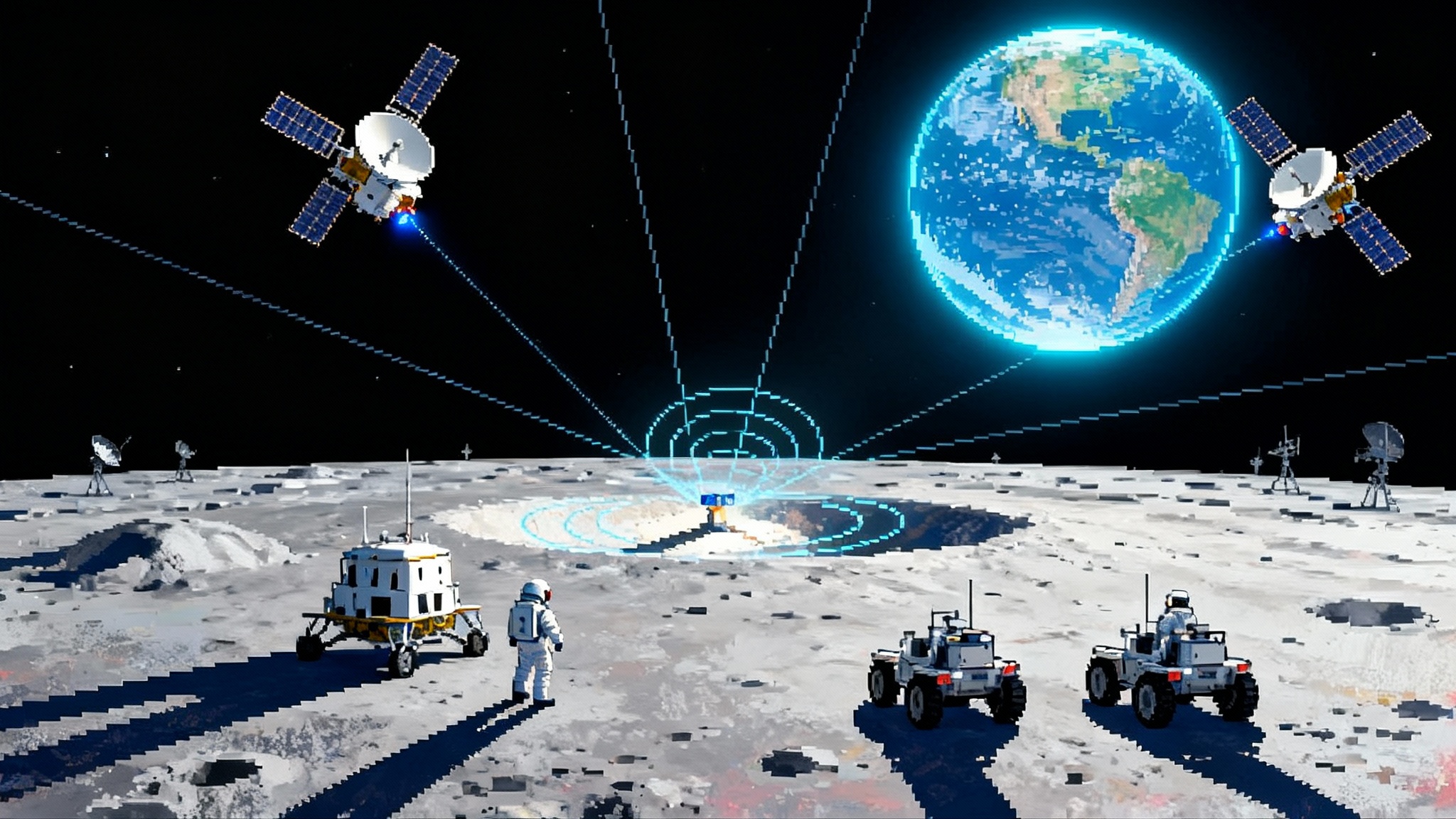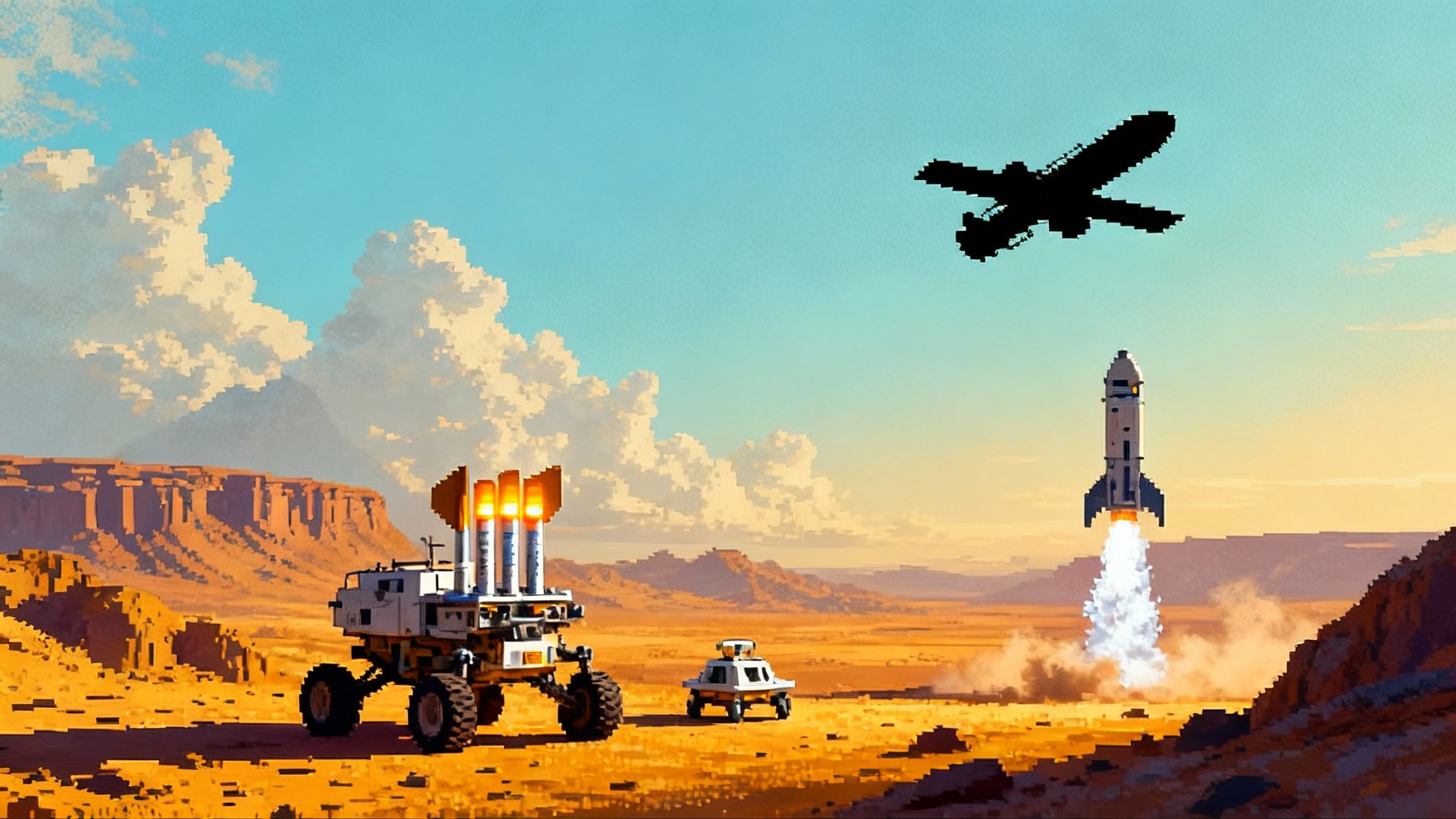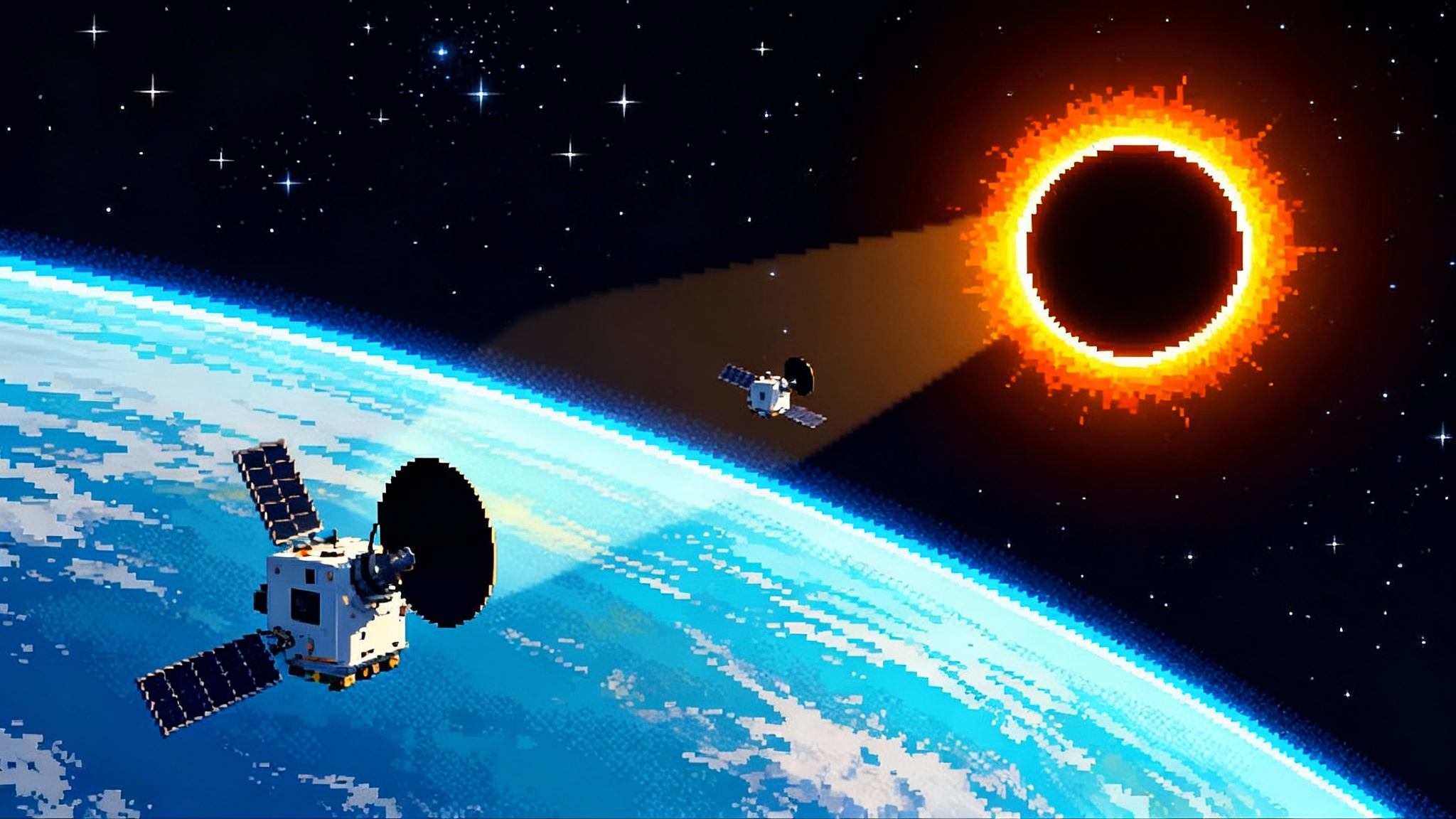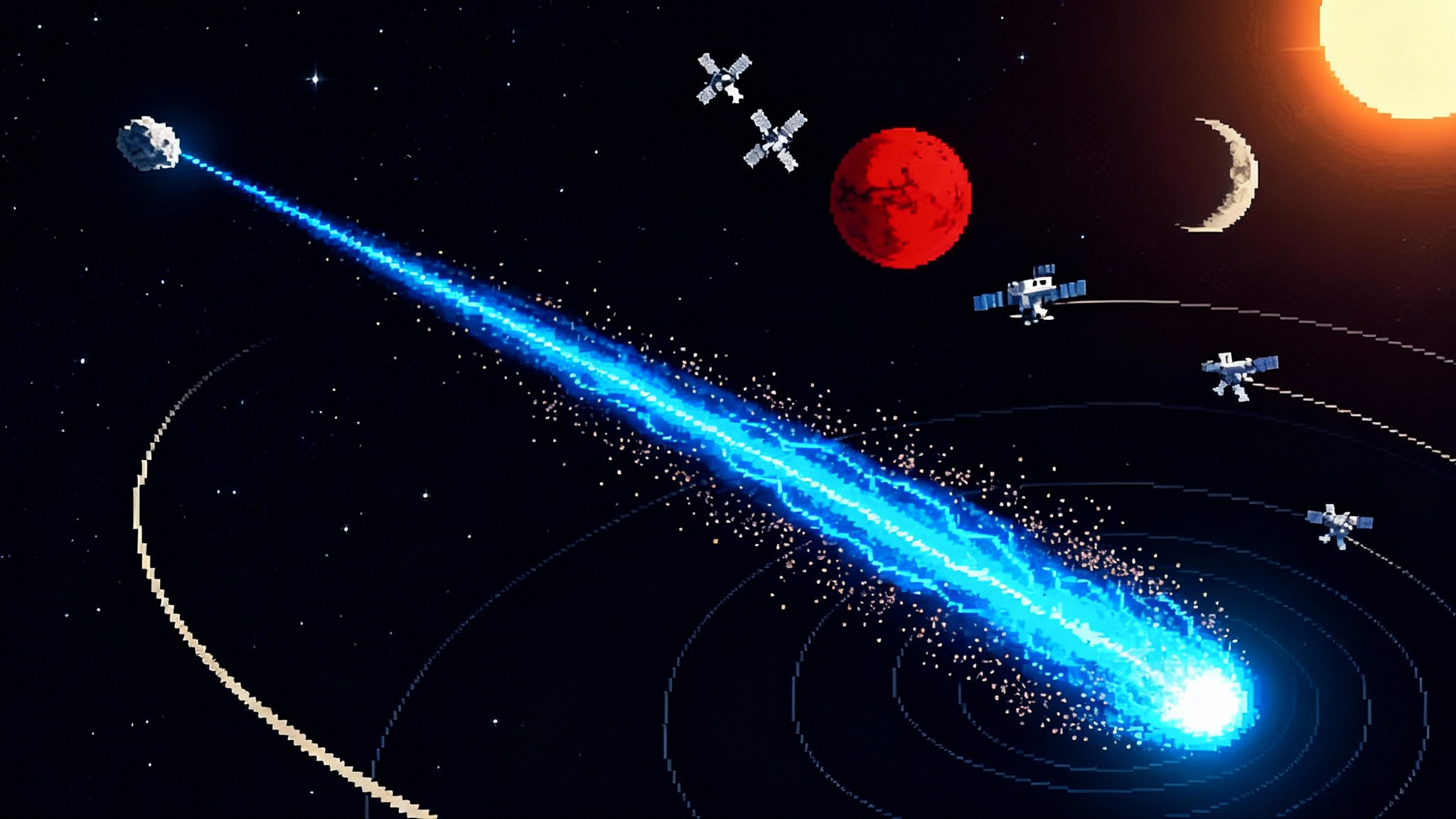Moonlight and LunaNet Ignite the Moon’s Navigation Grid
ESA’s Moonlight and NASA’s LunaNet standards are converging into a shared lunar communications and navigation backbone. The result: precision landings, real-time EVA support, and scalable rover swarms shifting from bespoke to routine between 2026 and 2030.

The quiet switch that changes everything
The most important lunar event of the decade is not a flag planting or a megathrust rocket. It is the moment the Moon gets its own version of cell towers and satnav. Europe’s Moonlight program and the LunaNet standards push are converging into a dedicated communications and navigation backbone that will let spacecraft and crews treat the lunar surface like a connected place rather than a dead zone. When that switch flips on for real, precision landings near the south pole, autonomous rover swarms, and real-time extravehicular activity coordination become routine. Just as Global Positioning System and mobile networks transformed life on Earth, a lunar network will quietly 10x mission cadence and capability.
This is not a vague promise. Agencies and industry have been aligning requirements and hardware for years. What is new is the operational mindset. Instead of packing a one-off relay radio and a bespoke navigation fix into every mission, Artemis partners and startups will book coverage and position services the way airlines buy navigation and communication capacity on Earth. The shift sounds subtle. The consequences are sweeping.
What Moonlight and LunaNet actually are
Moonlight is a European Space Agency effort to deploy lunar orbiters that broadcast navigation signals and carry high-throughput communications payloads. Think of it as the first permanent service layer for the Moon: timing beacons for positioning and relay links for data. LunaNet is the set of open, interoperable standards that make all of this usable by any mission that opts in. It spans networking, time transfer, security, and discovery, and it is designed to work even when line-of-sight is broken or when nodes are temporarily offline.
If you want a simple analogy, imagine a mountain rescue network that uses repeaters on peaks, a shared playbook for who can talk to whom, and a common clock so every team’s map aligns. Replace the mountains with lunar orbits like near-rectilinear halo orbits and polar frozen ellipses. Replace the teams with landers, rovers, habitats, and astronauts. Replace the playbook with LunaNet. The result is a consistent way to communicate and navigate across the Moon without each mission rebuilding the same infrastructure.
Why the south pole forces a new network
The south polar region of the Moon holds water ice in permanently shadowed craters and near-permanent sunlight on nearby ridges. That combination makes it the prime target for science and resource operations. It also breaks legacy communications and navigation assumptions. Deep shadows and rugged terrain limit direct line-of-sight to Earth. Low-elevation passes reduce link time. Optical navigation becomes tricky when one valley is pitch black and the next ridge is blinding. A backbone in polar orbits and halo orbits solves these constraints with persistent coverage and a reliable timing source, so that landers and rovers can plan paths and perform hazard avoidance with confidence. Recent missions like Chang'e-6 farside samples have sharpened the community’s focus on what comes next.
The technical core, explained simply
Three ideas make the backbone work.
- Shared time: A stable lunar time scale and precise time-transfer signals let receivers calculate position with a handful of beacons. If you know what time it is very precisely, you can measure how long a signal took to arrive, then compute distance and location. That is the essence of satellite navigation.
- Store-and-forward networking: Delay and disruption tolerant networking treats dropouts as normal. Packets can wait in an orbiter or a habitat until a peer comes into view. This is how you keep a conversation going when the Moon gets in the way.
- Service discovery and quality classes: Missions learn what nodes are in range and what services are available, then request the class of service they need. A rover can buy a low-rate, always-on link for telemetry while reserving a burst of high-rate downlink during a mapping pass.
Under the hood, radios span ultra high frequency for legacy compatibility, S band and X band for robust links, and optical terminals for high throughput. Navigation beacons can initially leverage spillover from Earth’s Global Navigation Satellite Systems but the long-term solution is dedicated lunar timing sources on Moonlight spacecraft, supplemented by surface beacons near landing zones.
From bespoke to bookings: the business model shift
Today, every lander or rover tends to carry more mass and complexity than its core job truly requires, because it must bring its own communications and navigation extras. A backbone turns those extras into a service you can book from orbit. The result is a new category: Navigation and Communications as a Service. Providers will offer service level agreements, coverage maps, minimum data rates, time-transfer accuracy, and application programming interfaces for session management and billing. For customers, fewer radios and antennas save kilograms and months of integration. For providers, predictable demand across many missions justifies investment in stable infrastructure. That is how an ecosystem gets past the artisanal phase.
What changes for Artemis partners between 2026 and 2030
The headline is speed and certainty. As commercial Moon landings in 2025 mature, here are the shifts that matter.
-
Precision landings become normal near the south pole. With continuous timing beacons and cooperative ranging, landers can perform terminal descent using relative navigation to pre-surveyed beacons and digital terrain maps tied to a common lunar reference frame. The practical result is meter-class touchdown accuracy next to scientifically interesting outcrops rather than kilometers away.
-
Astronaut extravehicular activities use continuous situational awareness. Suited crew carry low-power radios and navigation tags that maintain position and health telemetry through the backbone. Mission control sees each astronaut’s track, local terrain hazards, and oxygen margins. Crews see the same picture on wrist displays or heads-up visors. Real-time coordination is the standard mode.
-
Rover swarms scale without bespoke radio choreography. Prospecting swarms can fan out across shadowed craters while staying synchronized to a common clock. They can operate autonomously for long stretches, then sync maps and health data when an orbiter comes over the horizon. A single relay provider handles the mesh instead of each startup inventing its own.
-
Surface logistics standardize. Landers delivering cargo can reserve guaranteed downlink windows for crane operations and site surveys. Power-sharing microgrids can use low-latency links for protection and control. Asset tracking for pallets, drills, and sample canisters becomes plug-and-play because everything speaks the same discovery and identification protocols.
-
Mission design timelines compress. With a shared backbone, mission teams can rely on reference interfaces and coverage plans rather than bespoke coordination. Avionics teams focus on payloads and autonomy. Operations teams rehearse on digital twins fed by realistic coverage models. Procurement becomes simpler because communications and navigation are line items instead of long-lead developments.
-
International cross-support is real rather than ad hoc. A Japanese rover can route through a European orbiter while a Canadian payload logs time-transfer metrics from an American node. All parties account for usage the same way, because the standards and service definitions are shared.
-
Data becomes a product, not a scramble. High-rate imagery, ground-penetrating radar, volatile inventories, and navigation logs can be downlinked on predictable schedules and mirrored to customer-edge clouds on Earth. Scientists and operations engineers get data faster and with fewer gaps, and the long tail of small missions gains parity with flagships.
-
Safety margins improve. If a lander needs to abort a landing, the backbone supports robust trajectory updates and search-and-rescue localization. If a rover loses line-of-sight in a crater, it can still beacon through a polar orbiter and wait for help.
Behind these shifts sit real companies and programs. European primes and specialty firms are building orbiters, radios, and timing payloads. In the United States, contractors that already support Artemis communications, networking, and avionics are preparing LunaNet-compliant nodes. Commercial lander providers designing the next wave of deliveries are planning payload bays around smaller antennas and simpler radios because backbone access changes the trade.
A day in the life, south pole edition
Picture a cargo lander descending toward the rim of Shackleton crater. On final approach, it cross-checks a terrain-relative navigation camera with lunar timing beacons. A footpad touches down within three meters of a staked survey point. The lander’s mast antenna acquires a polar orbiter and immediately opens a standard data session. The site’s power system, a mix of solar arrays on a ridge and a battery heated against the cold, registers as a known node. It negotiates a low-latency slice for load control and a separate stream for health telemetry.
Hours later, a pair of rovers trundle off the deck. One is a scout configured for autonomous driving inside permanently shadowed regions. The other is a relay mule with a more capable antenna and a mast light. Both rovers keep the same time to the microsecond. The scout maps a frost-lined slope with lidar, then hands off its packet queue to the mule when a scheduled relay pass begins. A scientist in Houston watches a stitched 3D map that is hours old, not days.
The next morning, two astronauts step out from a pressurized rover. Their suit beacons mark their positions on a shared map that combines topography, communications signal strength, and illumination predictions. They cross a ridge and call out a patch of fractured rock. The mission’s geologist tags the outcrop in the shared workspace and the team decides to sample. A service reservation can guarantee a burst of bandwidth for high-definition video during that window. When they leave, a surface beacon remains so the next mission can find the site with centimeter accuracy.
None of this depends on a single mission’s radios working perfectly. That is the point. The backbone removes the fragility that has kept lunar operations slow and bespoke.
How a backbone de-risks the lunar economy
The Moon will only become a real economy if multiple actors can operate without tripping over each other or duplicating the same hard work. A backbone supports that in four specific ways.
- It reduces unit cost and mass. Missions buy service and remove kilograms of custom hardware, which translates to more payload or smaller launchers. The budget now flows to science instruments and industrial experiments instead of one-off radios.
- It increases predictability. Coverage plans and service classes let teams test operations months in advance. Investors can evaluate schedules with realistic assumptions about data return and navigation accuracy. Insurance underwriters can price risk based on shared performance logs rather than optimism.
- It enables modular specialization. Companies can build to a clean interface and compete on cost and performance within their niche. Rovers focus on mobility and autonomy. Orbiters focus on throughput and timing. Habitats focus on power and life support. The glue is the standard the community shares.
- It creates positive network effects. Each new orbiter adds coverage and capacity. Each new surface beacon improves landing accuracy and cooperative navigation. As density grows, the value of the network grows faster than the cost.
What startups should build next
The opening for young companies is not only in spacecraft. It is in software and services that ride the backbone.
- Autonomy stacks tuned for delay and disruption. The scheduling problem is new and rich: reserve high-rate windows for bulk data, plan traverses around coverage and illumination maps, and resynchronize swarm behaviors when the network comes back into view.
- Mission analytics and billing. Someone will provide multi-tenant dashboards that reconcile service reservations with actual usage, flag anomalies, and predict cost overruns. The first provider to make this boring and transparent will win trust.
- Edge processing on the Moon. Compress what matters near the source. Train compact models for hazard detection, mineral classification, power optimization, and machinery health on representative data on Earth, then run them at the edge. The network becomes more valuable when endpoints are smarter.
- Standardized surface beacons. A startup that makes rugged, low-power beacons with a common interface for placement near sites of interest will create a second-order effect on landing precision and asset tracking.
Governance and security without drama
Open standards do not mean a free-for-all. Service authentication, key management, and audit trails must be part of the default posture. The goal is simple: every node can prove who it is, every session can be verified, and every handoff can be reconstructed in case of anomaly. Public and private operators will need to agree on incident reporting and red teams. On the surface, contested spectrum is a risk. Providers should publish planned frequencies and enforce power limits. None of this is glamorous. All of it is essential if we want a backbone that endures.
From the Moon to Mars: the MARCONI template
The same ingredients unlock Mars, where the distances and delays are worse but the need is even clearer. A Mars backbone would mix areostationary communications satellites with highly elliptical orbits and relay payloads on Phobos and Deimos. Time transfer would center on a Mars time scale with drift management across the long Earth link. Delay tolerant networking would not be a specialty. It would be the normal atmosphere of operations. A handful of standard payloads would let landers, helicopters, and mobile laboratories join the network without custom work. For broader context on Mars logistics, see the 2025 commercial race for sample return.
We can call this template the Mars Communications and Navigation Infrastructure. MARCONI is a fitting name for a practical system that makes exploration routine. The lesson from Moonlight and LunaNet is not that a single nation leads or that a single vendor wins. It is that common services create the conditions for many missions to succeed at once.
The next two years are the hinge
The period between now and the end of 2027 is where the backbone either becomes a lived reality or slips into a familiar holding pattern. The hinge is not a drama about one launch date. It is a checklist.
- Fly the first orbiters with timing beacons and confirm position accuracy and link margins across polar sites.
- Publish complete service definitions, coverage maps, and pricing models so missions can commit. Make the paperwork boring and the interfaces familiar.
- Launch at least one surface mission that uses the backbone for terminal descent, not just for data return. That test will change design reviews across the industry.
- Seed a dozen permanent surface beacons at likely landing zones so that the second wave of missions inherits a more precise map than the first.
- Stand up a cross-agency incident and performance board and publish downtime reports and lessons learned. Reliability grows when problems are shared and fixed in daylight.
If these steps land on schedule, 2028 to 2030 will look different. Artemis partners will plan crewed sorties and cargo runs with the same assumptions commercial operators use on Earth. Startups will pitch products that assume a stable backbone and investors will finally have operational metrics to underwrite. The quiet switch will have flipped.
Conclusion: the reset we were waiting for
The Moon has always been close and hard. The way to make it close and workable is to stop inventing communications and navigation from scratch on every mission. Moonlight and LunaNet turn that insight into infrastructure. They make precision landings, real-time operations, and autonomous swarms the default state. They lower cost, raise safety, and remove the friction that keeps schedules slipping. Once the backbone exists, each new mission makes it better. That is the compounding engine that took the internet from curiosity to necessity. It can do the same for the Moon, and it can show us how to build MARCONI for Mars. The quiet switch is within reach. Flip it and the decade changes.








